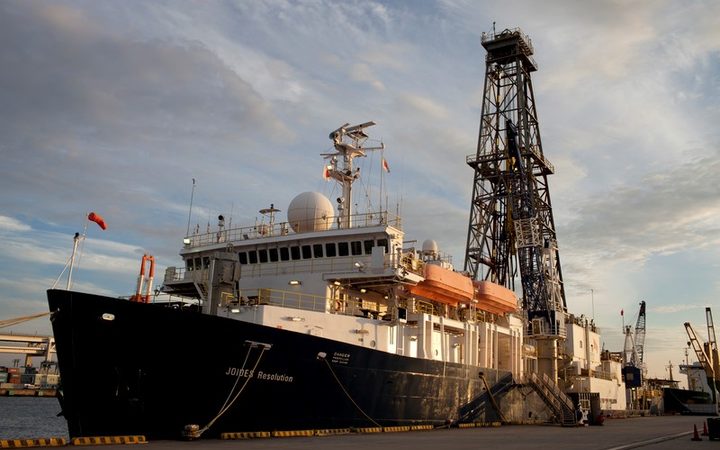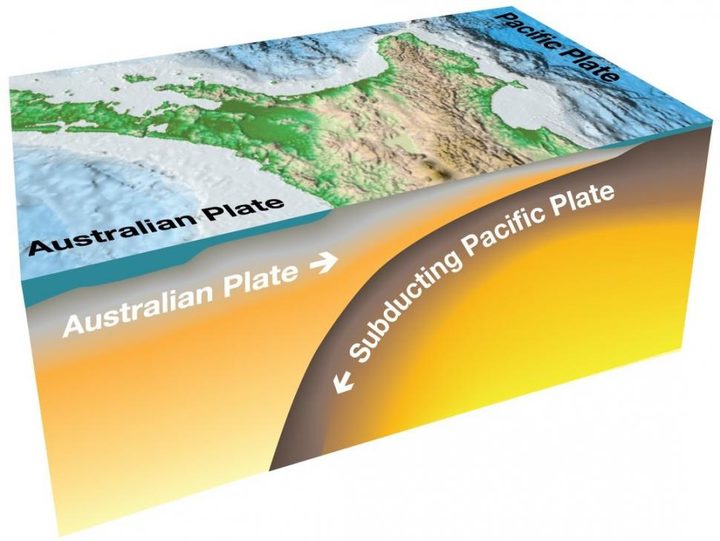Rocks from beneath the sea floor and even ancient under-sea
volcanoes are providing fresh clues about what could trigger and even
muffle potentially large earthquakes.
 A ship used for studying slow-slip earthquakes off New Zealand's east coast.
Photo: Courtesy of JRSO; CC0/PDM
A ship used for studying slow-slip earthquakes off New Zealand's east coast.
Photo: Courtesy of JRSO; CC0/PDM
Recent drilling missions of the sea floor near the Hikurangi
subduction zone off the east coast of the North Island has given a team
of New Zealand and international scientists a first look at the types of
rocks directly involved in slow slip earthquakes.
Slow slip earthquakes take place slowly over days to months, instead
of energy being released suddenly with sometimes catastrophic results.
They are a relatively new discovery, but studies so far have
indicated they can release pressure gradually on a stressed plate
boundary, but can also increase pressure at other locations along a
fault line.
The 2016 Kaikōura earthquake triggered a series of major slow slip
events on the Hikurangi subduction zone where the Pacific Plate dives
beneath the eastern North Island.
Two International Ocean Discovery Program expeditions to the area -
in 2017 and 2018 - mark the first time scientists from around the world
have studied and directly sampled rocks from the source region of
slow-slip events, using ocean floor scientific drilling methods.
New Zealand was considered to be one of the best places on earth to
study slow-slip because the affected sea floor was shallow, making
drilling for samples more viable.
 Photo: Supplied / East Coast LAB
Photo: Supplied / East Coast LAB
NIWA principal scientist Philip Barnes said the international science
community was still figuring out how these events related to large,
damaging earthquakes.
"What we've done here is really, for the first time we've been able
to target specific studies to get our hands on material that we can say
we think is involved in the slow-slip zone."
Dr Barnes said the latest discovery was significant to countries like
New Zealand, Japan and Costa Rica which sit on the Pacific Ring of
Fire.
He said the research missions also gathered geophysical data.
"When the bore holes were drilled, there were both core samples taken
from those holes and at the same time there were instruments in the
drilling technology that were providing a lot of physical properties
information about the formations that were being drilled through."
The study's co-leader Laura Wallace of GNS Science said they had
learned that earthquakes might also be affected by undersea volcanoes
formed 70 to 80 million years ago.
 Laura Wallace and Demian Saffer
on the JOIDES Resolution with one of two sub-seafloor earthquake
observatories that have been placed on the Hikurangi subduction zone.
Photo: Tim Fulton / IODP JRSO
Laura Wallace and Demian Saffer
on the JOIDES Resolution with one of two sub-seafloor earthquake
observatories that have been placed on the Hikurangi subduction zone.
Photo: Tim Fulton / IODP JRSO
Dr Wallace said the research had opened their eyes to the importance
of these undersea mountains and how much they might influence the
behaviour of seismic activity on the Hikurangi subduction zone.
"What we found with the drilling expedition was that these sea mounts
and the sediments around them had very different properties."
Dr Wallace said they were basically old, underwater volcanoes surrounded sediments of clay, mudstone and even limestone.
"All these things are being juxtaposed as they're carried into the
Hikurangi subduction zone - into that slow slip area, causing an
environment with lots of different rock types."
She said that caused different stress states on the plate boundary,
and a lot of plate motion was being absorbed by slow-slip events.
"That does mean overall that there are probably fewer really large
earthquakes, but with all this different (materials) composition you'll
have some strong spots where earthquakes might happen and you'll also
have weak spots around that."
Dr Wallace said the stronger spots were isolated and might therefore
reduce the size of an earthquake, because there was a smaller surface
area to rupture.
The findings meant that scientists might focus more on areas around a
subducting seamount, which could help them better understand and
predict where earthquakes were most likely to occur.



Comments
Post a Comment